Chlorite group
The chlorites are the group of phyllosilicate minerals common in low-grade metamorphic rocks and in altered igneous rocks. Greenschist, formed by metamorphism of basalt or other low-silica volcanic rock, typically contains significant amounts of chlorite.
| Chlorite group | |
|---|---|
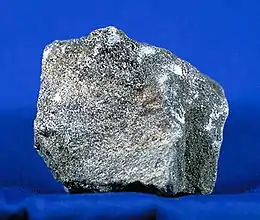 | |
| General | |
| Category | Phyllosilicates |
| Formula (repeating unit) | (Mg,Fe)3(Si,Al)4O10(OH)2·(Mg,Fe)3(OH)6 |
| IMA symbol | Chl[1] |
| Crystal system | Monoclinic 2/m; with some triclinic polymorphs. |
| Identification | |
| Color | Various shades of green; rarely yellow, red, or white. |
| Crystal habit | Foliated masses, scaley aggregates, disseminated flakes. |
| Cleavage | Perfect 001 |
| Fracture | Lamellar |
| Mohs scale hardness | 2–2.5 |
| Luster | Vitreous, pearly, dull |
| Streak | Pale green to grey |
| Specific gravity | 2.6–3.3 |
| Refractive index | 1.57–1.67 |
| Other characteristics | Folia flexible – not elastic |
| References | [2][3] |
Chlorite minerals show a wide variety of compositions, in which magnesium, iron, aluminium, and silicon substitute for each other in the crystal structure. A complete solid solution series exists between the two most common end members, magnesium-rich clinochlore and iron-rich chamosite. In addition, manganese, zinc, lithium, and calcium species are known. The great range in composition results in considerable variation in physical, optical, and X-ray properties. Similarly, the range of chemical composition allows chlorite group minerals to exist over a wide range of temperature and pressure conditions. For this reason chlorite minerals are ubiquitous minerals within low and medium temperature metamorphic rocks, some igneous rocks, hydrothermal rocks and deeply buried sediments.
The name chlorite is from the Greek chloros (χλωρός), meaning "green", in reference to its color. Chlorite minerals do not contain the element chlorine, also named from the same Greek root.
Properties
Chlorite forms blue-green crystals resembling mica. However, while the plates are flexible, they are not elastic like mica, and are less easily pulled apart. Talc is much softer and feels soapy between the fingers.[4][5]
The typical general formula for chlorite is (Mg,Fe)3(Si,Al)4O10(OH)2·(Mg,Fe)3(OH)6. This formula emphasizes the structure of the group, which is described as TOT-O and consists of alternating TOT layers and O layers.[3] The TOT layer (Tetrahedral-Octahedral-Tetrahedral = T-O-T) is often referred to as a talc layer, since talc is composed entirely of stacked TOT layers. The TOT layers of talc are electrically neutral and are bound only by relatively weak van der Waals forces. By contrast, the TOT layers of chlorite contain some aluminium in place of silicon, which gives the layers an overall negative charge. These TOT layers are bound together by positively charged O layers, sometimes called brucite layers. Mica is also composed of aluminium-rich, negatively charged TOT layers, but these are bonded together by individual cations (such as potassium, sodium, or calcium ions) rather than a positively charged brucite layer.[6]
 Crystal structure of chlorite viewed along [100] (looking along the layers)
Crystal structure of chlorite viewed along [100] (looking along the layers)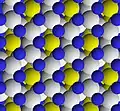 Chlorite structure viewed along [001] showing pseudohexagonal structure
Chlorite structure viewed along [001] showing pseudohexagonal structure
Chlorite is considered a clay mineral. It a nonswelling clay mineral,[7] since water is not adsorbed in the interlayer spaces, and it has a relatively low cation exchange capacity.[8]
Occurrence
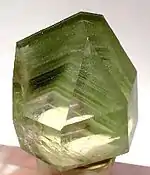
Chlorite is a common mineral, found in metamorphic, igneous, and sedimentary rocks. It is an important rock-forming mineral in low- to medium-grade metamorphic rock formed by metamorphism of mafic or pelitic rock.[9] It is also common in igneous rocks, usually as a secondary mineral, formed by alteration of mafic minerals such as biotite, hornblende, pyroxene, or garnet.[10] The glassy rims of pillow basalt on the ocean floor is often altered to pure chlorite, in part by exchange of chemicals with seawater.[11] The green color of many igneous rocks, slates, and schists is due to fine particles of chlorite disseminated throughout the rock.[10] Chlorite is a common weathering product and is widespread in clay and in sedimentary rock containing clay minerals.[9] Chlorite is found in pelites along with quartz, albite, sericite, and garnet, and is also found in associate with actinolite and epidote.[10]
In his pioneering work on metamorphic facies in the Scottish Highlands, G.M. Barrow identified the chlorite zone as the zone of mildest metamorphism.[12] In modern petrology, chlorite is the diagnostic mineral of the greenschist facies.[10] This facies is characterized by temperatures near 450 °C (840 °F) and pressures near 5 kbar.[13] At higher temperatures, much of the chlorite is destroyed by reactions with either potassium feldspar or phengite mica which produce biotite, muscovite, and quartz. At still higher temperatures, other reactions destroy the remaining chlorite, often with release of water vapor.[14]
Chlorite is one of the most common minerals produced by propylitic alteration by hydrothermal systems, where it occurs in the "green rock" environment with epidote, actinolite, albite, hematite, and calcite.[15]
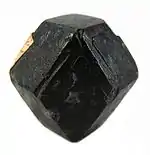
Experiments indicate that chlorite can be stable in peridotite of the Earth's mantle above the ocean lithosphere carried down by subduction, and chlorite may even be present in the mantle volume from which island arc magmas are generated.[16][17]
Members of the chlorite group
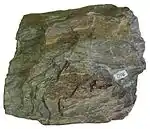
Baileychlore IMA1986-056 (Zn,Fe2+,Al,Mg)6(Al,Si)4O10(O,OH)8 Borocookeite IMA2000-013 LiAl4(Si3B)O10(OH)8 Chamosite year: 1820 (Fe,Mg)5Al(Si3Al)O10(OH)8 Clinochlore year: 1851 (Mg,Fe2+)5Al(Si3Al)O10(OH)8 Cookeite year: 1866 LiAl4(Si3Al)O10(OH)8 Donbassite year: 1940 Al2[Al2.33][Si3AlO10](OH)8 Gonyerite year: 1955 (Mn,Mg)5(Fe3+)2Si3O10(OH)8 Nimite year: 1968 (Ni,Mg,Al)6(Si,Al)4O10(OH)8 Pennantite year: 1946 (Mn5Al)(Si3Al)O10(OH)8 Ripidolite chlinochlore var. (Mg,Fe,Al)6(Al,Si)4O10(OH)8 Sudoite IMA1966-027 Mg2(Al,Fe)3Si3AlO10(OH)8
Clinochlore, pennantite, and chamosite are the most common varieties. Several other sub-varieties have been described. A massive compact variety of clinochlore used as a decorative carving stone is referred to by the trade name seraphinite. It occurs in the Korshunovskoye iron skarn deposit in the Irkutsk Oblast of Eastern Siberia.[18]
Uses
Chlorite does not have any specific industrial uses of any importance. Some rock types containing chlorite, such as chlorite schist, have minor decorative uses or as construction stone. However, chlorite is a common mineral in clay, which has a vast number of uses.[9]
See also
- List of minerals
- Thuringite
References
- Warr, L.N. (2021). "IMA–CNMNC approved mineral symbols". Mineralogical Magazine. 85 (3): 291–320. Bibcode:2021MinM...85..291W. doi:10.1180/mgm.2021.43. S2CID 235729616.
- Chlorite Group: Mineral information, data and localities, Mindat.org
- Nesse, William D. (2000). Introduction to mineralogy. New York: Oxford University Press. pp. 251–260. ISBN 9780195106916.
- Sinkankas, John (1964). Mineralogy for amateurs. Princeton, N.J.: Van Nostrand. p. 486. ISBN 0442276249.
- Klein, Cornelis; Hurlbut, Cornelius S. Jr. (1993). Manual of mineralogy : (after James D. Dana) (21st ed.). New York: Wiley. p. 514. ISBN 047157452X.
- Klein & Hurlbut 1993, pp. 500–501.
- Osacky, Marek; Geramian, Mirjavad; Ivey, Douglas G.; Liu, Qi; Etsell, Thomas H. (16 July 2015). "Influence of Nonswelling Clay Minerals (Illite, Kaolinite, and Chlorite) on Nonaqueous Solvent Extraction of Bitumen". Energy & Fuels. 29 (7): 4150–4159. doi:10.1021/acs.energyfuels.5b00269.
- Nadziakiewicza, Małgorzata; Kehoe, Sylvia; Micek, Piotr (23 September 2019). "Physico-Chemical Properties of Clay Minerals and Their Use as a Health Promoting Feed Additive". Animals. 9 (10): 714. doi:10.3390/ani9100714. PMC 6827059. PMID 31548509.
- Nesse 2000, p. 252.
- Klein & Hurlbut 1993, p. 522.
- Yardley, B. W. D. (1989). An introduction to metamorphic petrology. Harlow, Essex, England: Longman Scientific & Technical. p. 121. ISBN 0582300967.
- Yardley 1989, p. 8.
- Yardley 1989, p. 50.
- Yardley 1989, pp. 64–68.
- Wilkinson, Jamie J.; Chang, Zhaoshan; Cooke, David R.; Baker, Michael J.; Wilkinson, Clara C.; Inglis, Shaun; Chen, Huayong; Bruce Gemmell, J. (May 2015). "The chlorite proximitor: A new tool for detecting porphyry ore deposits". Journal of Geochemical Exploration. 152: 10–26. doi:10.1016/j.gexplo.2015.01.005.
- Manthilake, Geeth; Bolfan-Casanova, Nathalie; Novella, Davide; Mookherjee, Mainak; Andrault, Denis (6 May 2016). "Dehydration of chlorite explains anomalously high electrical conductivity in the mantle wedges". Science Advances. 2 (5): e1501631. doi:10.1126/sciadv.1501631. PMC 4928900. PMID 27386526.
- Grove TL, Chatterjee N, Parman SW, et al. (2006). "The influence of H2O on mantle wedge melting". Earth Planet. Sci. Lett. 249 (1–2): 74–89. Bibcode:2006E&PSL.249...74G. doi:10.1016/j.epsl.2006.06.043.
- "Seraphinite: Mineral information, data and localities". www.mindat.org. Retrieved 22 Mar 2019.
Further reading
- "Chlorite". Maricopa.edu. Archived from the original on 12 November 2004. Retrieved 22 Mar 2019.]